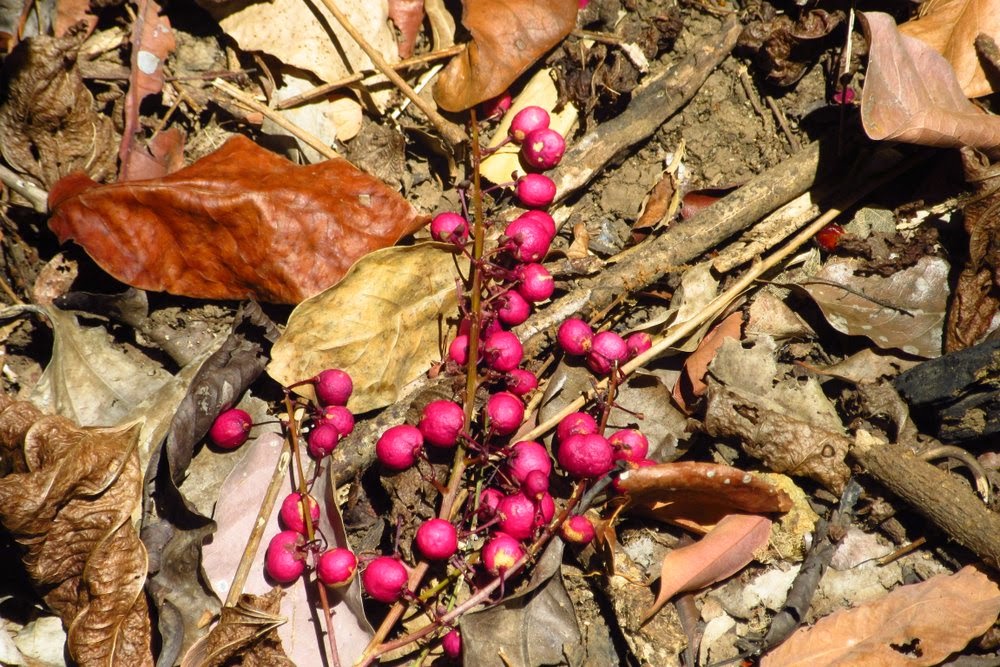We were pleased when Professor Ricardo Trota Jose (Rico) of the University of the Philippines History Department asked to join us for the weekend. Rico's first trip to Corregidor was in 1977, and his most recent was in the '90s. Sun Cruises brought video crews to Corregidor on Saturday and Sunday to film us walking along two of our favorite trails. (Are you getting the idea that every trail on Corregidor is "one of our favorite trails?") We are hopeful that a video will be put together for the purpose of promoting trail hiking on Corregidor, not only for history buffs, but for avid hikers and nature lovers as well.
Rico, Marcia, and Steve at the mandatory photo stop at Steve's father's gun at Battery Way, before heading into the jungle.
Steve telling Rico about Battery Sunset, which is not far from the trail.
At X-F-1, near Battery Hanna (X-F-2) Paul of SCI in the foreground, and Photographer Dale at center
Sun Cruises employee Tonie found this old medicine bottle
Rico and Steve at the Battery Hanna overlook
Rico and Steve resting under our favorite banyan tree
Audio specialist Dan exiting Wheeler Tunnel
The first day's photo shoot ended with a tour through the ground floor of a senior officer's duplex
On day 2, the hike began at Kindley Field. Here are Paul, Julia, Marcia, Steve, Rico, and Tonie, with Caballo Island in the background.
Steve telling Rico about the Japanese landing on May 6, 1942, with photographer Alex in the foreground
Steve and Rico on the very dry Kindley Field, with the video crew looking on
Steve kidded Tonie that she reminded him of the Grim Reaper, with the walking stick that resembles a scythe. One way to battle the heat here is to wear clothes that breathe and don't allow direct sun to reach the skin.
Tonie and Marcia found this large and beautiful blossom, yellow as you can see, with a deep burgundy throat - we'd love to know the name!
When we'd almost reached the eastern tip of the Tail, Marcia took this telephoto view of the towers on Topside, nearly three miles away.
Rico found this shell (ammo) holder far down the tail. With Julia looking on, Rico explains that it was part of the internal framework for an ammo case, designed to hold the shells in position within the case. It being made of wood, it's amazing that it hasn't long since ended up in a fisherman's cooking fire.
Videographer Alex in a bird's-eye-view shooting location
Notice that Alex is using a tripod to steady the camera, but against his own torso, not the ground. We've got to try this!
The grass that was all burned away on our previous visit is starting to grow back. After rainy season begins, all traces of the fire will soon be gone.
One last look at Hooker Point...the tide level was too high for us to cross the land-bridge today.
And one last look at Caballo Island. We said the same thing a few weeks ago. Never say never.
It was hot, and when we finally rounded the tip of the tail (going from the north side to the south side) we found some of the lead walkers had tucked into the shade of a very convenient rock ledge.
After that we returned to Corregidor Bay by banca (small double outrigger) rather than retracing our steps along the same path. We recommend that Sun Cruises make this an option, which will add to the expense of the hike but offers three big advantages. The first is that you don't have to return over the same trail, which requires more uphill hiking and can be very tiring when it's as hot as it's been for the past two days. The second is that the banca ride allows the hikers an up-close view of the north shore of Corregidor, territory that they would otherwise only see at a distance from the ferry. The third is that less-conditioned and older hikers can participate.
Because it was windy during our return trip, we did not risk taking the camera out and subjecting it to possible saltwater splashes. Below are a few select photos of the north shore taken on a previous banca ride around the island in September (rainy season) of 2010, so they are not as sunlit as if we had been able to take them today. The terrain is also far greener, for two reasons; the previously mentioned fire has left much of this part of the Tail mostly bare, and what vegetation we encountered today is crispy dry.
Does anyone else - besides Marcia - see this little rock formation as a person sitting cross-legged and cross-armed, looking right at us?
Love that little tree on the point! It always reminds us of something from Dr. Seuss.
Same little tree, up close
Malinta Hill center, the "head" of the island (Middleside & Topside) right
We recently hiked both of these trails, and because we were not being videotaped at the time, took many more of our own photos. If you want to see those earlier stories,
they are available at::
and:
We wish to thank Professor Rico Jose for joining us and graciously taking part in the videotaping. We are very hopeful that both of these trails will soon be a part of Sun Cruises' alternative offerings.
Steve and Marcia on the Rock






























































































